It’s time for the annual end-of-year musings known as Shadows and Reflections. Since so many of our lives were lived in thematic overlap this year, we’ve asked our contributors and friends to focus on the small, strange and specific as they look back over the last 12 months. Today it’s the turn of Melissa Mouchemore.
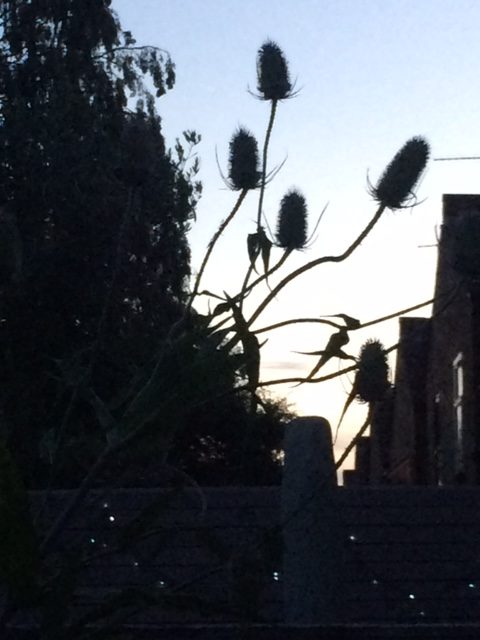
January
Rummaging around for something lost in the dim of the garden shed, I come across a small pot marked in my own hand GERANIUM. I have no memory of this but the seed has already rooted, shooted and a small confident plant has formed. I might make a go of this one, it looks like it can take care of itself.
February
I release the geranium into the chilly ground. Mostly I am off through the front door to catch the bus or hurry round to the shops. But I clock it as I go back and forth to the washing line. It does not wilt or rot. The feeble London frost is easily shrugged off. Its leaves elongate and radiate outwards at ground level. It seems happy in its new spot.
March
Very happy. As the air warms the London clay, its leaves rapidly multiply; starbursts within starbursts, each spear-head vibrantly green, each mid-rib cabbage-white with a delicate line of spikes running along its underside. I wonder if this is a geranium. But I get caught up again indoors, am often cycling off into the London streets.
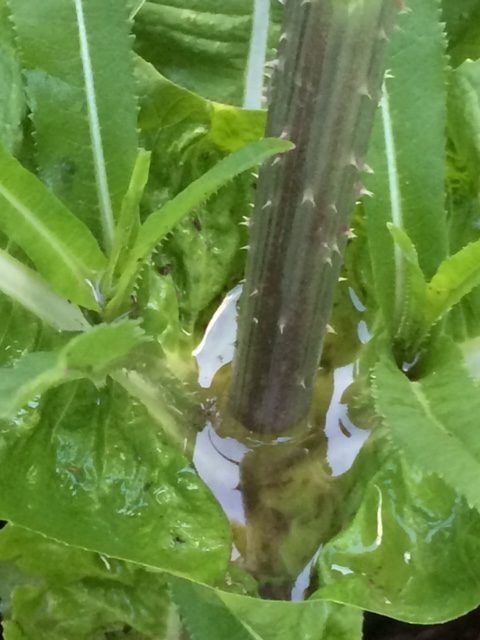
April
I am outside in the back garden. My now daily standing still, staring. The blue sky expands above and below the ‘geranium’ also expands, an emerald sunburst, its rays rippling and puckering in the heat. It is rising up too, a periscope out of the earth, now up to my knees. Every inch is coming out in a spike or prickle. The sturdy stem, spiny of course, is the diameter of a penny. What have I planted? Knotweed? Triffid? I zap it with an App. A moment’s buffering. And then,
‘It’s a teasel’ I call into the kitchen as if announcing the gender of a new-born.
I know teasels! I knew what a teasel was before I ever saw or touched one. Alison Uttley’s Little Grey Rabbit stories taught me in childhood about teasels; the bristling seed heads used by the squirrels to brush their tails. Well, I knew how a hairbrush felt and sounded. And the name gives you clues; the teeth of the brush teasing out the strands, raking any tangles. When I finally saw a teasel head, picked for decoration, I was intrigued and delighted by this weird sci-fi microphone.
I picture what my teasel will become. But I have never witnessed the manufacturing of the squirrel tail brush. At the epicentre of the plant a tight knot is emerging, the texture of a buzz cut, the colour of lime juice. Such green is like a splash of cold water on my face. My daily standing still and staring now has a focus.
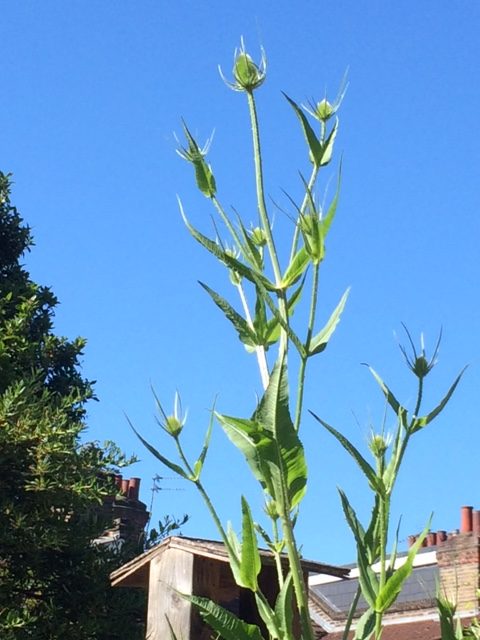
May
The teasel has shot up above my shoulders, my head. And it is not one squirrel brush. It is many-headed, each the shape of a grenade held in a basket of barbed wire bracts. They have been fired out of reach on their long stems, some intertwining, the largest erupting straight upwards crowning the whole plant. It glows at its core with vivid green, the spikes strobe a darker interference and at the outermost rim, where the tips meet the sunlight, a white force field zings. I was right about it taking care of itself.
June
I google ‘Teasel’. Compare measurements; this teasel, if it is a wild one, is top of the range. It must be 8 feet high. I try a final tally of brushes, craning my neck – 8, 10, no 14 – enough for an extended family of squirrels. I worry it might topple in a strong breeze but it sways and rights itself, perfectly engineered. At its base the main stem is now the diameter of a pound coin.
As the solstice approaches the bracts form rings around each seed head, the arms of worshippers held aloft around their henge. I can only look up and wonder at this visitation.
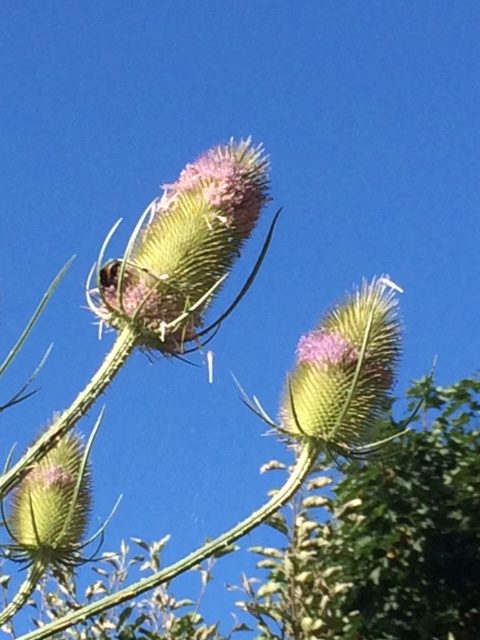
July
Two bands of tiny flowers appear around each seed head, soft as towelling, chalky mauve against grass court green. I am glued to the teasel instead of the tennis this year.
The bees also seem glued. They land on the flower bands and just stick. Are they poisoned, dead? I tap with a broom handle– they fall, recover and heavily fly away. That must be some nectar.
August
The teasel is an Italianate water feature after a summer shower. The starburst leaves, attached directly to the stem, form tiered bowls to collect rainwater. I wonder if in a downpour they overflow like a tower of champagne glasses? I had only known the teasel as a tinder-dry plant. But there are clues to its watery qualities in its alternative names; Venus’s basin, The Tears of Venus, and its Latin name Dipsacus, meaning ‘thirst for water’. Dipsacus seems apt – dipping a finger in its ‘dew’ and rubbing tired eyes is an old remedy. I consider the viscous pools, dotted with drowned aphids, and decide against it.
The occasional tatty petal is dropping into the pools now. Others are caught on the spikes. The teasel is turning a paler green. The bees come to their senses and move on to the lavender.
September
On my bike again. A new term. But still in thrall to the teasel. It is more familiar now the colour has drained to parchment and shoe polish brown. In early morning it glistens with spider threads. A dowager in silk tipsily leaning over the fence into the neighbours. I hope they don’t disapprove. I feel protective towards the teasel.
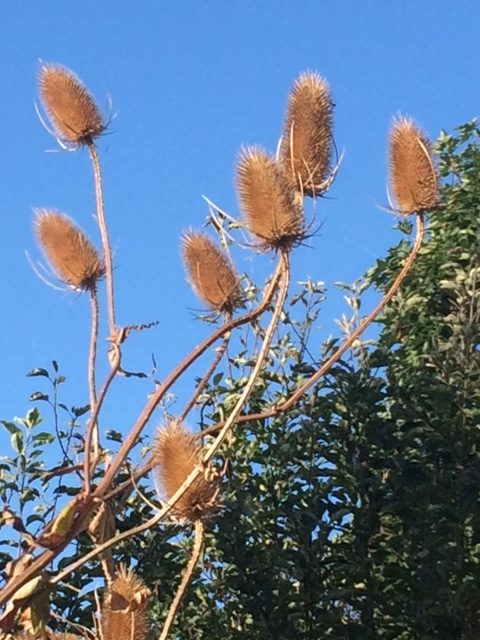
October
Did I say protective? In a fit of tidying I fell the teasel. Yes I fell it. I worry that it may not be to everyone’s liking nosing over a fence. Well it must have served its purpose – the seeds surely already spent.
I have to use the strong, long-armed clippers. What is left in the ground is the hollow stem that so reliably held and tethered the entire structure. Its outer coating has a cellophane sheen. I slice off a section and look through its oval window, blow into it like a panpipe. Now I understand its Latin name; that is quite a water channel.
November/December
I examine the squirrel brushes closely now they are housed in a jug. It is impossible to resist playing the bristles; a two tone zither with a third tone twang. I practice applying just the right pressure in an upward direction to avoid any sharp jabs. The spikes are pleasingly pliant, a quality prized in the wool trade where they were used for carding and raising the nap of fine cloth. No wonder they were good for squirrels’ tails.
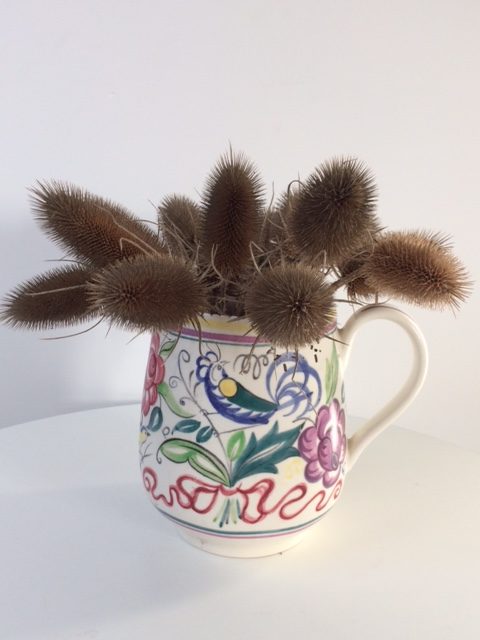
With each stroke of a brush I realize shamefully that the teasel is nowhere near done. Dark seeds ping all over the table top, onto the floor in iron filing scatters. I sweep up and tip them on the bird table; the teasel could have been its own winter bird feeder, goldfinches perching on its prongs. In the misty morning the spiders have found other structures on which to drape their jewellery. The teasel could have had diamonds and pearls, how fitting for a dowager. I think of all I have learned and wonder what I still don’t know. I will place the jug of brushes on the Christmas table and wait for starbursts next spring.